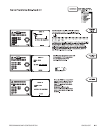
PROGRAMMING AND CONFIGURATION CM9760-SAT 2-3
NOTE:
The operator on the
9760 SIDE
and on the
SAT SIDE
must have some independent means of communicating with each other.
NOTE:
It is not necessary for the called camera to actually be attached on the
SAT SIDE
.
All you are doing here is tying up a tie line to your
reference monitor so that anything put on the tie line can be viewed from that display.
a. Initialize or reinitialize (as the case may be) the KBD on the SAT SIDE; use a monitor-out number that has been allocated
as a tie line.
NOTE:
More than likely, you would use MON 1, as the object here is to match the monitor-out line initialized on the
SAT SIDE
with the
video tie line secured or referenced on the system side in step 2. The 9760 system normally grabs the first tie line available. Since no
tie lines are allocated for use but the one we called, it should be the one connected to the MON 1 output from the SAT. This tie line
should correspond to the first video input configured in the Cameras file as a tie line for the SAT.
b. On the SAT SIDE, enter program mode as usual:
1) Press the PGM key
A “P” appears on the KBD LED display.
2) Enter the password (default 2899100) and ACK it.
c. The program menu should appear on the system-side monitor selected in step 2. The operator on the 9760 SIDE can now check,
correct, add, subtract or otherwise change all attributes of the SAT menu system. When all changes are made and the operator
attempts to exit the menu using choice (9) in the menu, the display reverts to the SAT’s program PASSWORD menu, which flashes
intermittently on the monitor display. At this time, the only way to exit the program is for the operator on the SAT SIDE to press the ACK
key. Once this is done the SAT operator should immediately reinitialize the SAT keyboard to the local SAT monitor display.
Figure 2-3
Programming Diagram Three
INFORMATION BOX
The coordination issue in this example could be avoided if you ran a
KBD200/KBD300 from the remote keyboard port located on the rear
of 9760-SAT back to the head-end, or 9760 SIDE of the configu-
ration. Then program entry and exit could also be handled by the
9760 operator. In essence, this would amount to doing local SAT
SIDE programming from the 9760 SIDE of the configuration.
Program entry and exit would use the KBD300 and SAT program-
ming would use the 9760KBD. See Figure 2-3.
PRELIMINARIES
4a. Programming Variation Example: 9760-SAT Programming Minus Preset Call
This scenario illustrates the situation referenced in point 2, above.
The rationale for using this variation might be:
The local SAT programmer is not sure of the correct parameters to enter; or,
The local SAT programmer wants certain aspects of an operational or reprogrammed SAT to be checked by supervisory personnel located
on the 9760 SIDE of the configuration; or,
The programmer on the SAT SIDE might be unavailable; no one on the 9760 SIDE remembers the preset call function or remembers how
to use it, and so on.
Proceed as follows:
1 From the 9760 SIDE, ensure that no one, other than the person doing the programming, is using a tie line for any purpose.
2. Call up a satellite camera to a viewable system monitor. Use the logical number for the referenced camera.
COMMENTS
With reference to Figure 2-3 and the Information Box above, we
can make the following observation:
To persist in programming the SAT from a 9760 keyboard when a KBD300
is available on the 9760 SIDE is just a convoluted version of Program-
ming Configuration I. Even so, there are some advantages to con-
sider for this configuration:
1. You can program the SAT from the 9760 SIDE without using a preset call function.
2. You can use the KBD300, rather than the 9760 keyboard for SAT programming. The KBD300 is more efficient for programming SAT menus.
3. You can still control local SAT functions from the 9760 SIDE and eliminate the need for a downstream operator.


















